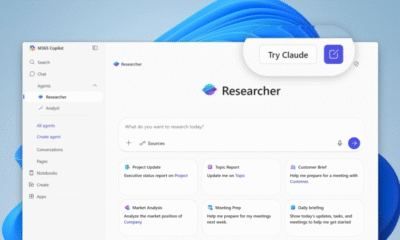AI
The Rise of ‘Digital Twin’ Consumers: The Potential Demise of Traditional Surveys

A Revolutionary Breakthrough in Market Research: AI Simulating Human Consumer Behavior
A groundbreaking research paper recently unveiled a game-changing method that empowers large language models (LLMs) to emulate human consumer behavior with remarkable precision. This advancement has the potential to revolutionize the multi-billion-dollar market research industry. By enabling the creation of synthetic consumers capable of providing realistic product ratings and qualitative reasoning at an unprecedented scale and speed, this technique promises to reshape the landscape of consumer insight generation.
Previous attempts to leverage AI for market research have been hindered by a critical flaw: when prompted to assign numerical ratings on a scale, LLMs often produce unrealistic and poorly distributed responses. The newly published paper, “LLMs Reproduce Human Purchase Intent via Semantic Similarity Elicitation of Likert Ratings,” offers an ingenious solution to circumvent this issue.
Conceived by an international team of researchers led by Benjamin F. Maier, the innovative method known as semantic similarity rating (SSR) diverges from the conventional approach of soliciting numerical ratings from LLMs. Instead of numbers, SSR prompts the model to express a detailed textual opinion on a product. These textual responses are then transformed into numerical vectors, or “embeddings,” which are compared against a set of predetermined reference statements. By assessing the semantic closeness between the generated text and the reference statements, the model can infer the appropriate rating for the product.
The results of the study are nothing short of remarkable. When evaluated against a substantial real-world dataset from a prominent personal care company, which included 57 product surveys and 9,300 human responses, the SSR method demonstrated an impressive 90% human test-retest reliability. Notably, the distribution of AI-generated ratings closely mirrored that of the human panel. The researchers assert that this framework enables the scalable simulation of consumer research while upholding traditional survey metrics and interpretability.
Addressing the Threat to Survey Integrity Posed by AI
This breakthrough comes at a critical juncture as the integrity of conventional online survey panels faces mounting challenges from AI interference. A recent analysis from the Stanford Graduate School of Business highlighted the emergence of a concerning trend where human survey participants employ chatbots to fabricate responses. These AI-generated answers were characterized as excessively positive, verbose, and lacking the authenticity and diversity of genuine human feedback, potentially skewing data and concealing critical issues such as bias or product deficiencies.
In stark contrast to the contamination of data resulting from uncontrolled AI interventions, Maier’s research offers a structured approach to generating high-fidelity synthetic data from scratch.
One industry analyst, unaffiliated with the study, remarked, “The Stanford paper showcased the chaos caused by unregulated AI infiltrating human datasets. In contrast, this new paper demonstrates the order and utility of controlled AI creating its own datasets. For Chief Data Officers, this signifies a shift from remedying tainted data to leveraging pristine data sources.”
Technical Advancements Driving the Era of Synthetic Consumers
The efficacy of the new method hinges on the quality of text embeddings, a concept explored in a seminal paper published in EPJ Data Science in 2022. This research emphasized the importance of a robust “construct validity” framework to ensure that text embeddings truly capture the essence of purchase intent.
The success of the SSR method suggests that its embeddings effectively encapsulate the subtleties of consumer behavior. To achieve widespread adoption, enterprises must have confidence in the models’ ability not only to generate plausible text but also to establish meaningful correlations between text and scores.
This approach represents a significant departure from prior research efforts, which primarily focused on utilizing text embeddings to analyze and predict ratings based on existing online reviews. For instance, a 2022 study evaluated the performance of models like BERT and word2vec in forecasting review scores on retail platforms, with newer models like BERT demonstrating superior predictive capabilities. In contrast, the latest research transcends mere analysis of existing data to generate novel insights preemptively, even before a product enters the market.
The Emergence of Digital Focus Groups
The implications of these technical advancements are profound for decision-makers in the technology realm. The ability to swiftly create digital replicas of target consumer segments and conduct rapid testing of product concepts, advertising content, or packaging variations promises to accelerate innovation cycles significantly.
Furthermore, synthetic respondents generated through SSR offer rich qualitative feedback elucidating the rationale behind their ratings, providing a wealth of actionable insights for product development in a scalable and understandable manner. While traditional human focus groups remain relevant, this research underscores the readiness of synthetic counterparts for practical application.
From a business standpoint, the advantages are compelling. A standard survey panel for a national product launch typically entails substantial costs and weeks of implementation. In contrast, an SSR-driven simulation can deliver comparable insights swiftly and affordably, with the flexibility to iterate based on immediate findings. Particularly in fast-moving consumer goods sectors where speed-to-market is paramount, this agility can confer a decisive competitive edge.
However, it is essential to acknowledge certain limitations. While the method’s efficacy has been validated for personal care products, its performance in complex B2B purchasing scenarios, luxury markets, or culturally specific product categories remains unverified. Additionally, while SSR can replicate aggregate human behavior, it does not purport to predict individual consumer choices, emphasizing population-level trends over individual preferences.
Despite these constraints, the research marks a significant milestone. While human-centric focus groups retain their relevance, this study presents compelling evidence that synthetic counterparts are poised to make a meaningful impact. The pertinent question now shifts from whether AI can mimic consumer sentiment to whether enterprises can swiftly leverage this capability to gain a competitive advantage over their rivals.
-

 Video Games3 days ago
Video Games3 days agoTekken 8: Rise of the Shadows
-

 Video Games2 days ago
Video Games2 days agoGoku Takes on the Dragon Ball FighterZ Arena
-

 Amazon3 days ago
Amazon3 days agoNeil Young Takes a Stand: Pulling Music from Amazon in Protest of Jeff Bezos’ Support for Trump
-

 Tech News3 days ago
Tech News3 days agoSamsung Galaxy UI 8: Embracing the Big Free AI Upgrade
-

 Security3 days ago
Security3 days agoCritical Vulnerability Exposed: Oracle EBS Targeted in Recent Cyber Attacks by Cl0p Hackers
-

 Apple3 days ago
Apple3 days agoExploring the Dystopian Realms of Pluribus: An Apple Original Series Trailer
-

 Microsoft3 days ago
Microsoft3 days agoEnhanced Copilot Features: Creating Office Documents and Gmail Integration
-

 Microsoft18 hours ago
Microsoft18 hours agoMicrosoft Integrates Anthropic’s Claude AI Models into 365 Copilot: A Deepening Relationship with OpenAI






























